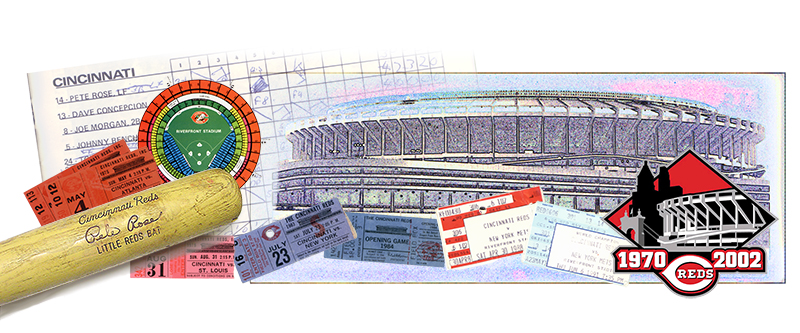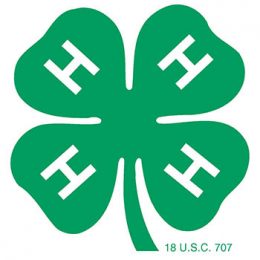(This column originally was printed in the April 2002 issue of Electric Consumer.)
May 1975 … three neighborhood buddies, two sisters, one set of parents … road trip to Cincinnati … the Reds and the Atlanta Braves … baseball, hot dogs and Bat Day … Oh, wow!
As if on a journey to Oz, we wound our way— up from our hometown on the Hoosier banks of the Ohio — till we arrived at the gates of that pearly stadium gleaming on the water’s edge. Riverfront Stadium teemed with some 50,000 fans circling above that synthetic green baseball diamond. To a 13-year-old fan, Riverfront in the 1970s was baseball’s Emerald City.
So, it’s hard to fathom that after this season, the once-touted “Gem on the Ohio” will be no more. In 2003, the Cincinnati Reds will move into a new ballpark being built next to Riverfront (known as Cinergy Field since 1997). It’s hoped the new park will help revive the franchise that — much like Cinergy Field — has lost its luster in recent years.
In the mid-1970s, it was a different story. Cincinnati was the center of the baseball universe. And on that May weekend in 1975, the Big Red Machine, powered by Hall-of-Famers-to-be Johnny Bench and Joe Morgan and Cooperstown-calibre Pete Rose and Tony Perez, was on its way to a World Series Championship. The Reds would repeat as World Champs in 1976.
Though the Ohio River ran Cincinnati Red past my hometown, especially in those days, that carload I road in was a bit of an anomaly. There wasn’t a Reds fan among us. The family I was with all rooted for the Braves. My other buddy was a St. Louis Cardinals fan. I was a New York Mets fan.
I was not as excited about seeing the Reds and Braves as I was about seeing my first major league game between the Mets and the Cardinals the year before. Still, I was thrilled to be going to Cincinnati. The Reds were a team for the ages with power and poise. All of baseball respected its players and manager, Sparky Anderson. And, like the Reds at that time, that stadium was larger than life.
No one knew then those big “multi-use” arenas built for baseball and football in the mid- and late- 1960s would become obsolete so soon. By the 1980s, baseball fans, sports writers and movies became nostalgic for baseball’s golden days. The beauty of unique confines like Wrigley Field and Fenway Park was rediscovered. Baseball and host cities accommodated by building “retro parks” individually designed to offer wonderful sight lines for fans and the deluxe suites for business. The retro parks drew sell-out crowds and lots of dollars and spelled doom for the big cookie-cutters.
It’s even kind of ironic: when the Reds moved to its new home on Cincinnati’s riverfront in 1970, the beauty of its namesake was ignored. Reds fans didn’t know what they were missing in their big bowl until the left and center field portions of the stadium were knocked down last year to make way for the new park. Suddenly, a view the Ohio was opened to fans. The new ballpark will take advantage of the location.
Riverfront allowed record numbers of fans to see one of baseball’s great dynasties. But in the long run, some of the intangible closeness with the team and the game might have been lost amid all the concrete and artificial turf.
To a kid in 1975 impressed with size and numbers, though, those first moments at Riverfront were awesome. “Intangibles” meant nothing.
In the Sunday game that May weekend, we saw baseball’s 1,000,001st run score. All day the giant scoreboard in center field counted to the big landmark millionth run until it got to 999,999. Then, Reds shortstop Dave Concepcion hit a solo homer in the fifth inning. All 50,000 of us thought he’d done it — and we’d seen it. It didn’t matter to me that we were almost in the last row of seats at the top of the stadium. But then, moments later, the scoreboard announced that Bob Watson of the Houston Astros scored the millionth run while Concepcion was rounding the bases. Still, it was Bat Day, and I still have my Pete Rose bat.
(We didn’t really realize it at the time, but the Saturday game was much more significant in the life of the “Big Red Machine.” That was the first game Rose, who’d always played left field, started at third base, a move credited with cementing the line up.)
Years later, another trip to Riverfront would bring similar bittersweet feelings. That was 1984.
I copped some tickets in January for Opening Day to see the Reds and Mets. In 1983, my boyhood hero, pitcher Tom Seaver, returned to New York after five seasons in Cincinnati to presumably end his Hall-of-Fame career where it started. Obviously, he would be the Mets Opening Day pitcher at Cincinnati April 2. That’s what I thought, at least.
But days after I got the tickets, the Chicago White Sox shanghaied Seaver away using some cockamamie thing called the “Free-Agent Compensation Pool.” The Mets, rebuilding with young talent, left the aging star off its list of “protected” players. Two months later, I was still fuming as I skipped classes at Indiana University and drove to Cincinnati. It was a beautiful spring day, but the Reds hammered the Seaver-less Mets 8-1.
Other Riverfront memories included a game between the Mets and the Reds the year before, when both teams were cellar dwellers. Seaver didn’t pitch, but at least I saw him warming up! That game’s highlight was watching a rubber chicken thrown around the stands along the third-base side before landing on the playing field in front of the Mets dugout. When a Mets player non-chalantly tossed the fowl run-afoul into the dugout, the crowded started chanting, “We want the chicken, we want the chicken.”
So the Mets, who in the meantime had cut the chicken’s extremities off, tossed it back into the stands piece by piece. The fans lost interest. The scoreboard then announced that a limited number of chicken sandwiches were available at concession stands. Oh, the Mets lost that game, too, 6-3.
In all the years I’ve proudly worn my Mets orange and blue to Riverfront, I have to hand it to Reds fans: they never treated me the way I’ve heard New Yorkers treat opposing fans — except maybe once — April 30, 1988. That was the night of the infamous Pete Rose-Dave Palone game.
During the close game, Rose, then-Reds manager, disputed a critical call with Palone, the first base umpire. During the argument, Palone accidentally poked Rose with a finger. Rose retaliated with a hard shove. Rose was ejected and the crowd went crazy. For 15 minutes debris rained onto the field, driving Palone from the field. The Reds faced a forfeit. When the game finally resumed, the Reds ended up losing 6-5.
Outside Riverfront that night, three drunken Reds fans stopped me. But it wasn’t my blue Mets jersey that initially brought trouble. It was the red Indiana University sweatshirt I pulled over the top of it for camouflage before leaving my seat. First they said obnoxious things about IU. Then one noticed the orange and white trim and blue of the jersey peeping up around the collar, and added, “Oh …! He’s also a … Mets fan,” peppering the phrase with words straight out of the standard Bob Knight dictionary.
My friend and I escaped unscathed only after the other two guys sobered up enough to drag their buddy away. My Pete Rose bat could have come in handy that night!
The next day, I came back, neutrally dressed, with the sports editor of the newspaper where I was a photographer. We had media passes. From the field, I saw actor Dustin Hoffman sitting near Reds owner Marge Schott. He was in town making the movie “Rainman.”
Then I saw the Mets clobber the Reds 11-0. Afterward, Rose, addressed the media in his office. Growing impatient with the questions about the Palone incident the night before, he abruptly and effectively ended the news conference when he stood up from his desk and took off his pants in front of us all.
That shove later cost him a month-long suspension. This, of course, was nothing compared to the lifetime banishment from baseball he received a year later for allegedly betting on baseball.
In the following years, I made occasional trips. My last trip to Riverfront was in 1991. The strike of 1994 left a bitter taste in my mouth toward the game that took awhile to pass. And, after visiting a few of the new retro parks over the past several years, including the Indianapolis Indians’ beautiful minor league park in downtown Indianapolis, I’ve decided Riverfront really isn’t such a great place to watch a game after all.
But, this year, I will try to make one last trip to Riverfront for old time’s sake. Since turning 40 in January, I’ve become awfully nostalgic about the places echoing from my youth, especially those that are now lost or on the verge of passing. Unlike the Ohio, the queen river flowing persistently past Cincinnati’s downtown, Old Man Riverfront won’t keep rolling along after this season. But these memories and many others made there over the years fortunately always will.
Text and photo illustration by Richard G. Biever, senior editor of Electric Consumer.



